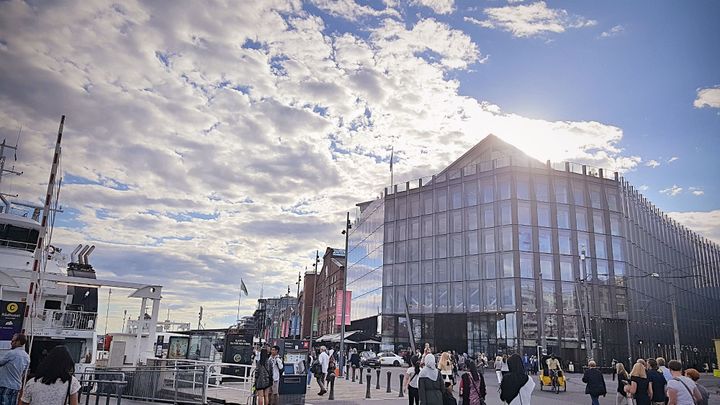
The popular Aker Brygge restaurant and business district of Oslo's Harbour Promenade.
With a British royal wedding on the horizon, there seemed to be no better time than the present to go wheels up again on my self-proclaimed “royal tour” of Scandinavia. This time I stop over in Oslo, perhaps the most personally intriguing of all the destinations on my itinerary if only because it was the city about which I knew the least in addition to being home to the royal family with whom I was least familiar. That said, tag along as I spend a whirlwind 48 hours in Oslo. But first, a little royal backstory (and again, if royal intrigue is of no interest to you, skip ahead to the “48 Hours in” section for a look at the highly recommended highlights of my visit).
The Royal Story
Just as in Denmark, the Norwegian monarchy dates back for more than a thousand years. However, for purposes of this particular narrative, the House of Glücksburg, which acceded to throne in 1905 after the dissolution of Sweden and Norway, will once again take center stage. That said, it is interesting to note that for the better part of the previous five or so centuries, Norway was essentially forced into alliances and ruled under the monarchs of its Scandinavian neighbors. From 1818 – 1905, the originally French House of Bernadotte, from which the Swedish royal family is descended, ruled both Sweden and Norway. And prior to that, from 1380, a single monarch ruled both Denmark and Norway.
Against this backdrop, it is of particular note that Norway’s current reigning monarch is descended from a line of monarchs that began with a king (Prince Carl of Denmark) who was actually elected by the people of Norway in a landslide popular referendum. In a rare turn of events, as the world around them roundly began to reject monarchies, Norway embraced the idea and after more than 600 years without a monarch of its own, Norway once again reclaimed one by popular demand.
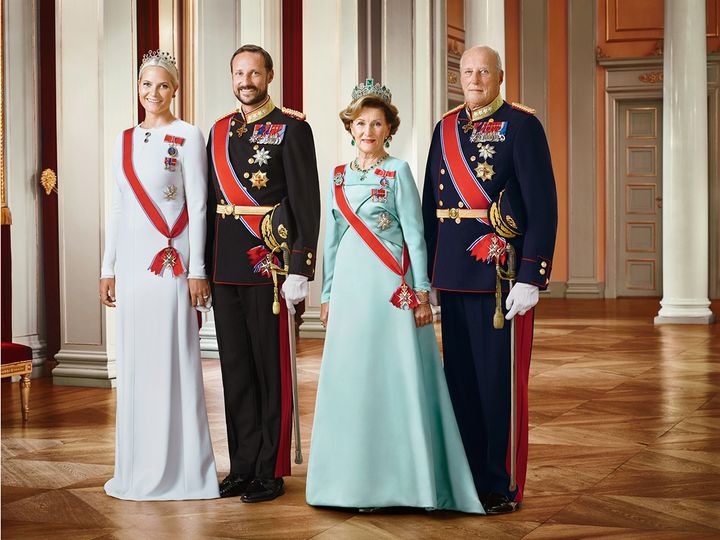
(From L to R) HRH Crown Princess Mette-Marit, HRH Crown Prince Haakon, Her Majesty Queen Sonja and His Majesty King Harald V.
Providing yet another example of the far-reaching import of the marriages of Queen Victoria’s offspring, the people’s choice was not only a member of the well-established House of Glücksburg but also married to his cousin Princess Maud, granddaughter of Queen Victoria and daughter of the then Prince of Wales and the Princess of Wales (born Princess Alexandra of Denmark), later King Edward VII and Queen Alexandra of the United Kingdom.
More than a century later, the House of Glücksburg continues to reign in Norway with great popularity. In fact, one recent report found that eight out of ten Norwegians favor the monarchy. All of which is very good news to the current members of the Norwegian Royal House which is made up of Their Majesties King Harald and Queen Sonja and Their Royal Highnesses Crown Prince Haakon, Crown Princess Mette-Marit and Princess Ingrid Alexandra.
The Next Generation
Before we get to the next generation, a few words must be said about the current generation inasmuch as the choices of King Harald V may very well have influenced those of his son and heir Crown Prince Haakon. Predating the marriage of Prince William, Duke of Cambridge to the future Duchess of Cambridge, by more than four decades, then Crown Prince Harald nearly triggered a constitutional crisis when he chose commoner, Sonja Haraldsen, to be his intended. However, after enduring a nine-year courtship, the couple were finally granted permission to marry in 1968 and the former Sonja Haraldsen became Norway’s first (and enormously popular, I might add) queen in more than 53 years.
Now how’s that for a Cinderella story?
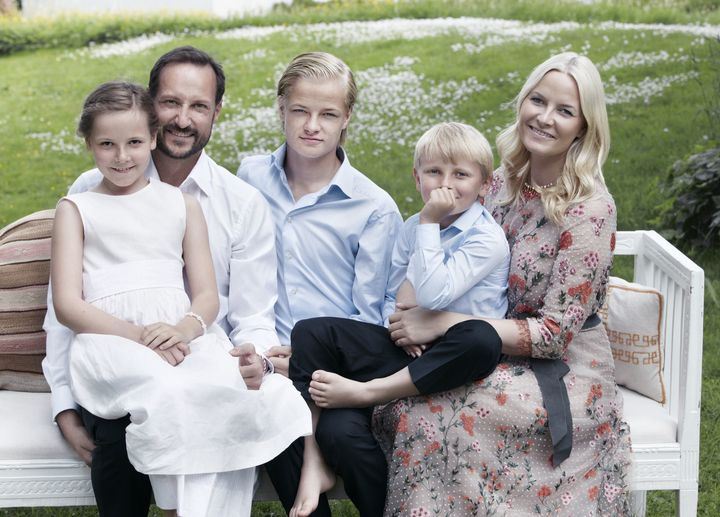
The next generation of Norwegian royals including HRH Princess Ingrid Alexandra (L) who is next in line to the throne after her father HRH Crown Prince Haakon.
Like his father before him, in 2000 HRH Crown Prince Haakon also made a marital alliance that shook the royal rafters when he married Mette-Marit Tjessem Høiby who was not only a commoner but a single mother of one. The picture of a modern royal, HRH Crown Princess Mette-Marit has juggled her official role, her professional ambitions and motherhood with an agility common to most contemporary parents (albeit with all the trappings of royalty).
After her marriage to Crown Prince Haakon, the newly anointed Crown Princess continued to study ethics at the Faculty of Social Science and the Faculty of Humanities at the University of Oslo before continuing on to follow courses at the School of Oriental and African Studies at the University of London where she took examinations in HIV/AIDS and Development and The Global Refugee Crisis, among other topics. In 2012, the Crown Princess even completed her Master of Management at BI Norwegian School of Management in Oslo.
Along the way, the Crown Prince Couple welcomed two children of their own –Her Royal Highness Princess Ingrid Alexandra and His Highness Prince Sverre Magnus. According to Norwegian constitution the order of succession is lineal, irrespective of gender, so Her Royal Highness Princess Ingrid Alexandra is next in line to throne after her father Crown Prince Haakon. In an interesting aside, the eldest son of the Crown Princess, Marius Borg Høiby, who never held an official title, nonetheless announced last year that he was leaving public life and planning to attend a university in California. Proclamations aside, taking into account Mr. Høiby’s status as something of an international heartthrob, anonymity may not come quite so easily to this member of the Norwegian Royal brood, particularly given his proclivity for social media.
Modern Connections
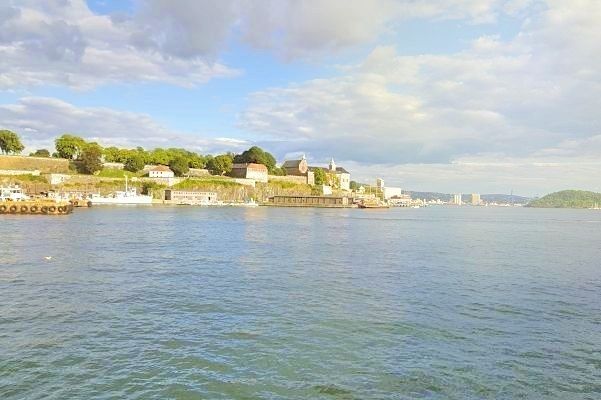
New meets old along Oslo's Harbour Promenade.
Where to begin?
First of all, His Majesty King Harald V is, as mentioned above, a direct descendant of King Edward VII and thereby of Queen Victoria, which makes him a second cousin of Queen Elizabeth II and the first foreign monarch in the line of succession to the British throne. It then follows that HRH Crown Prince Haakon is third cousin to HRH Charles, Prince of Wales and by consequence of his place as a descendant of King Edward VII, eligible to succeed to the thrones of the sixteen Commonwealth realms which include Canada, New Zealand, Australia and The Bahamas.
But here’s the more interesting connection. If you’ll recall from above, at the time of her marriage to Prince Carl of Denmark who would later become King Haakon of Norway, the future Queen Maud was the daughter of the Prince and Princess of Wales who would later become King Edward VII and Queen Alexandra of the United Kingdom.
Now it is established fact that King Edward VII was quite the playboy and well known for his romantic dalliances before and after succeeding to the British throne. Of all those dalliances, there was none more famously significant to the Prince of Wales and future King Edward VII than the one he enjoyed with Alice Keppel, his long-term mistress with whom he remained intimate until his death. In fact, so intimate with the monarch was Keppel that her role was acknowledged by the long-suffering Queen Alexandra who even allowed Keppel to attend King Edward’s deathbed.
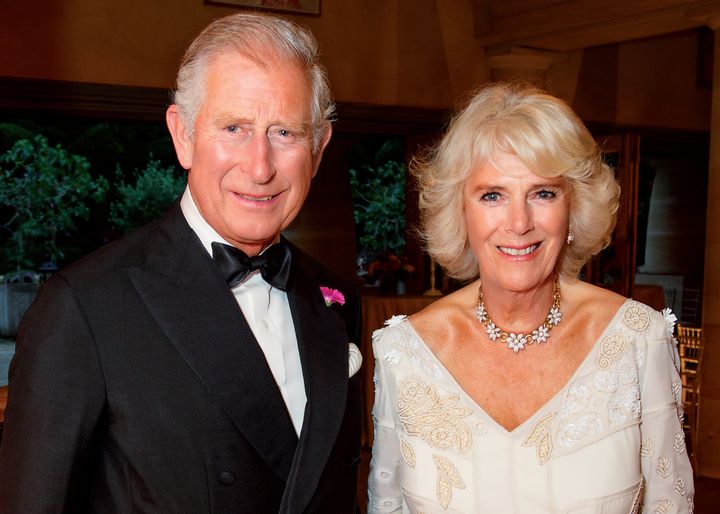
History repeating. HRH Prince Charles (L) is the great grandson of King Edward VII and HRH Duchess of Cornwall (R) is the great granddaughter of King Edward VII's longtime mistress, Alice Keppel.
In a case of history repeating, Keppel’s great granddaughter is none other than Camilla Parker-Bowles, Duchess of Cambridge, whose mésalliance with the current Prince of Wales only came about after a very public scandal that brought down one of the most talked about royal marriages of the modern era. Interestingly, Keppel is known to have thought discretion to be the key to managing royal affairs. Which is why, in the wake of Edward VII's grandson, Edward VIII, abdicating the throne to marry the twice-divorced American Wallis Simpson, Keppel is attributed with having said, "Things were done much better in my day."
One wonders if she would say the same about her great granddaughter if she were alive to see her in Clarence House today.
The Royal Palace
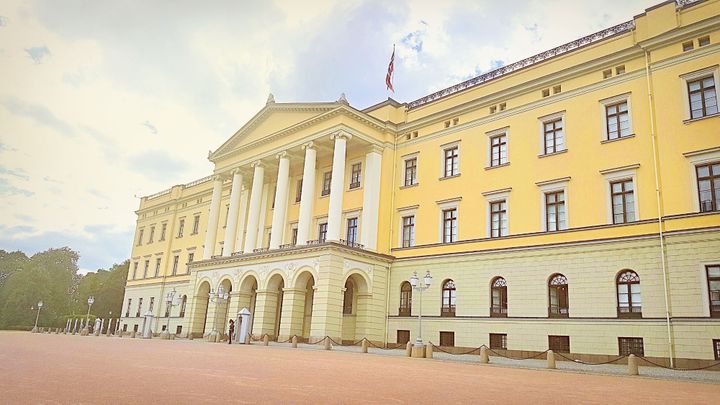
The Royal Palace, Oslo
aAlmost as if surveying its surroundings, the Royal Palace sits regally on a rise at the end of Oslo’s main thoroughfare, Karl Johans gate. It is the primary home of Their Majesties King Harald and Queen Sonja and also the site where the royal couple receives and hosts foreign heads of state. Surrounding the palace, is the Palace Park, one of the Norwegian capital’s first and largest parks, filled with gardens created around the ideal model of nature that prevailed in European horticulture in the mid-1800s.
The Royal Palace is but one of several royal residences in Norway. Other royal residences open to the public include, the summer palace of Oscarshall, Stiftsgården, Gamlehaugen and Ledaal.
48 Hours in Oslo
Following a short flight on Norwegian from Copenhagen I touched down at Gardermoen Airport in Oslo, picked up my luggage and hopped on the conveniently located Flytoget express train – feeling quite happy with myself, I might add, for having purchased my ticket in advance via the app for the train service. Obviously, there are other options for getting into the city, included among which are bus and taxi service, but I had been advised that the quickest, easiest and most efficient way of getting into the city was this particular express train and I couldn’t imagine that any other mode of transport could have been simpler.
Flytoget deposited me at Nationaltheatret Station right in the very heart of Oslo, which is where I would proverbially plant my flag for the next 48 hours. Upon arrival, I traversed the swarming platform at the busy station, which is a major hub in Oslo, then made my way outside to discover a fine and sunny afternoon (contrary to popular conception such do exist in Oslo).
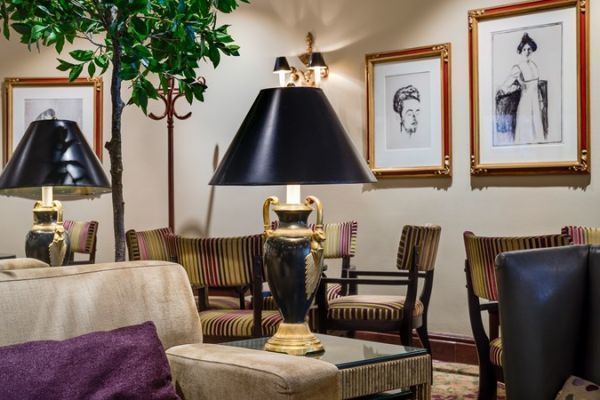
Works by Edward Munch and other acclaimed artists adorn the public spaces of the Hotel Continental, Oslo.
Within a minute or two, I stood in the lobby of the historic Hotel Continental, just steps away from the station. Distinctively grand and imbued with the sweep of history even then, the lobby and reception areas of the more than century old hotel are currently undergoing a major renovation which is certain to ensure that arrivals are welcomed in as dazzling a fashion as they have been since the property first opened its doors in 1900.
Once settled into one of the hotel’s handsomely renovated corner junior suites, I stepped onto the balcony which overlooked the square surrounding the Nationaltheatret Station. From here I could glimpse the tiniest sliver of a view of the Royal Palace and I was fascinated to see how all activity in the city still flows from the Royal Palace which peers out over Oslo from a promontory into which the city’s main drag Karl Johan’s Gate directly leads. Standing at such an ideal vantage point, I could almost imagine what court life must have been like in Norway an age ago.
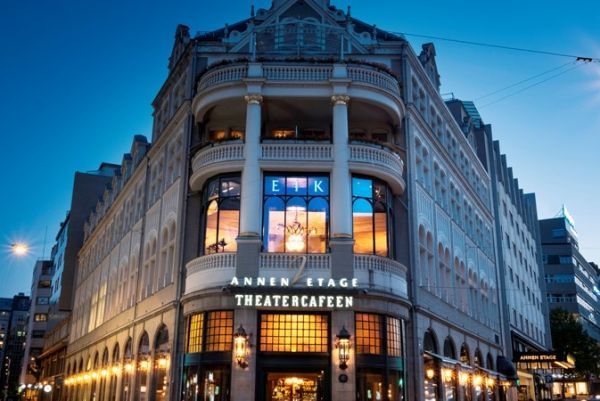
Exterior entrance to Theatercaféen at the Hotel Continental, Oslo.
Armed with nothing more than Google Maps, I decided to take the first of many quick strolls through the city. Fittingly, as this was my royal tour, my first stop was the Royal Palace and the surrounding Palace Park, which is open to the public year-round. Immediately I was struck by how accessible the Palace was and how liberally tourists, and locals alike, enjoyed access to the surrounding Park grounds. The very epitome of a people’s palace, all around me crowds of tourists took photos in front of the Royal Palace, while others just milled about taking afternoon strolls or plopping down here or there for a quick rest. For my part, I chose to take a lap around the Palace.
On the whole, I found the royal residence imposing in size, if not particularly ornate. However, of all the stops on the pleasant trek, my favorite was the Queen’s Park, formerly a private Rococo garden that is now part of the Palace Park open from May to October. Twas truly a tranquil delight.
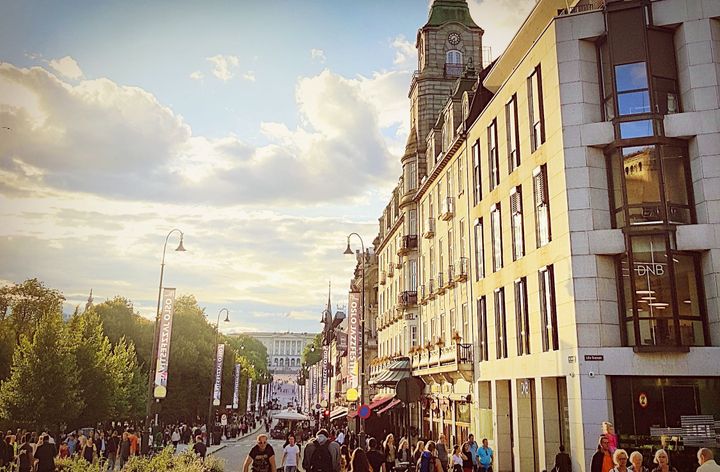
Shopping Karl Johan's Gate, one of Oslo's busiest throrougfares which leads directly to the Royal Palace.
My Palace tour complete, I strolled back down Karl Johan’s Gate into town stopping off at Egertorget Square to visit Eger Karl Johan, Norway’s largest purveyor of luxury goods, and continuing on to Nedre Slottsgate and Promenaden, the nucleus of a paradise of cafés and boutique emporiums included among which are iconic international luxury brands like Louis Vuitton, Hermès and Bottega Veneta as well as local high-end outlets like Kamikaze, Vincci and the Steen & Strøm department store.
Because, as the old adage goes, time flies when you’re having fun, it wasn’t long before I found that my reservation for cocktails and dinner at the Hotel Continental’s famed Theatercaféen would soon be upon me. So, I put my shopping exploration on hold and headed back to hotel to change for dinner.
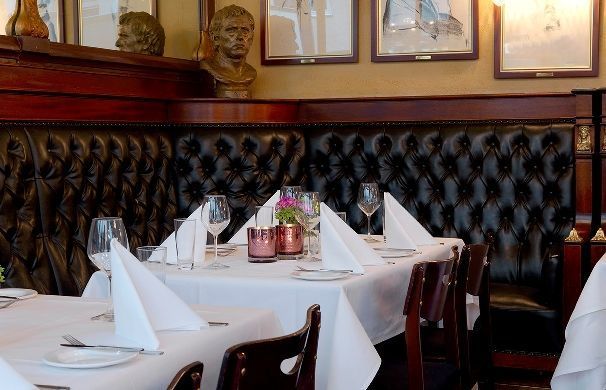
Inside the Art Nouveau Theatercaféen at the Hotel Continental, Oslo.
Also opened in 1900, just one year after Oslo’s neighboring National Theater, Theatercaféen is an Art Nouveau gem. Once inside, one feels transported back to the grandeur of dining out in the early 20th century. Walls are lined with an array of portraits immortalizing Norwegian personalities, authors, writers, actors, painters, musicians and composers who have been (or still remain) regulars at the restaurant. Meanwhile dark wood and leather banquettes pair, to dramatic effect, with intimate tables draped in white cloth under a canopy of ornate moldings, arches and vintage lighting fixtures, all of which add a uniquely romantic quality to the space. As for the menu, imagine a seasonal French brasserie with Nordic flair. As all things old are new again, the menu, like the restaurant, is at once retro and decidedly modern. Think eyepopping presentations of Beef Tartare served with Danish Rye bread, Moules Frites, Oysters and Caviar, Duck Confit and Truffle Risotto.
After a relatively early first night, I awoke early the next morning to continue my exploits and my first stop wasn’t far beyond the door of my suite. En route to breakfast at Caroline, I took a look around the property in search of the artwork for which the hotel is famous. In the Dagligstuen lobby bar, I found the hotel’s collection of works by Edward Munch, one of the largest private collections of its kind in Norway, while elsewhere I found works by the likes of abstract artist Jakob Weidemann and visual artist Ulf Nilsen. It is rare that a hotel is a mini-gallery unto itself, but the Hotel Continental is such a place, in large part thanks to its long association with the artistic community.

A stunning view from Oslo's Harbour Promenade.
Following breakfast, I walked to the bustling Harbour Promenade, a seaside mecca of restaurants and shops, which was bursting at the seams with activity on this particularly pleasant fall morning. When I arrived patrons had already begun to fill the outdoor patios of the endless assortment of eateries of every conceivable variety that line the revitalized harbour. However, before I could get to far I looked into the Nobel Peace Center if only because I could. After all, when in Oslo.
I continued my walk along the Aker Brygge restaurant and business district of Promenade enjoying the breeze and the range of modern architecture that dotted it before arriving at the Thief, one of Oslo’s newest and hippest hotels. Formerly a haven for smugglers, thieves and scoundrels known as Tjuvholmen (Thief Islet), the ultramodern Thief hotel is today a favorite of the likes of Rihanna and superstar DJ David Guetta. A richly decorated selection of rooms and suites, state-of-the art gym and spa facilities, ultraluxe amenities and a credo of treating “rock stars like guests and guests like rock stars” are all part of the hotel’s allure as is its reputation for epitomizing cool and serving as a premier destination for nightlife in downtown Oslo.

Inside a suite at the Thief, Oslo.
In addition to an art space presenting the work of emerging contemporary artists, the Thief also boasts a Thief Music Unplugged series showcasing current stars and bubbling under artists in an intimate setting. Moreover, of particular note for travelers like me with a fondness for mingling, there are the hotel’s restaurants and bars. While the dark, sexy, art-laden Thief Bar, along with its signature cocktail menu and seductive mix of patrons, is always a happening spot, The Roof Bar is also an undeniably attractive spot on which to enjoy cocktails. Weather permitting of course.
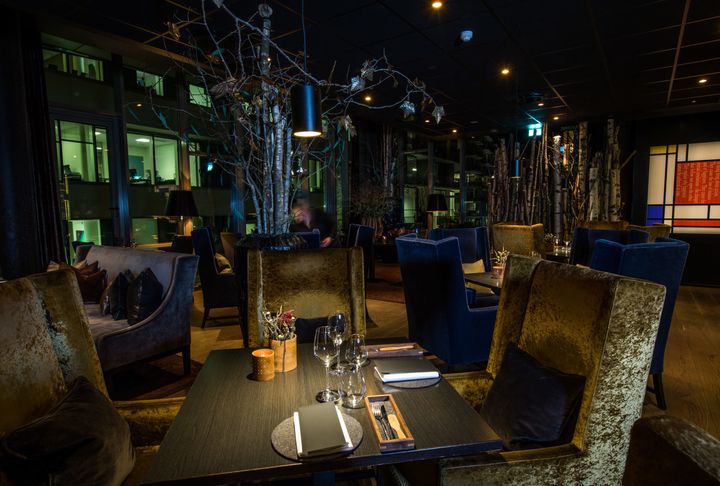
The Thief Bar.
In terms of restaurants, Food Bar, the Thief’s signature eatery, offers an excellent opportunity to experience global cuisine prepared with local ingredients and updated with modern Nordic panache. All of which explains why I suggest that whether you simply visit or actually book into the Thief, sampling its pleasures are a must.
Post-lunch, on my walk back from the Thief, I took advantage of the hotel’s proximity to attractions including The Astrup Fearnley Museum of Modern Art and the Tjuvholmen City Beach to while away the rest of the afternoon.
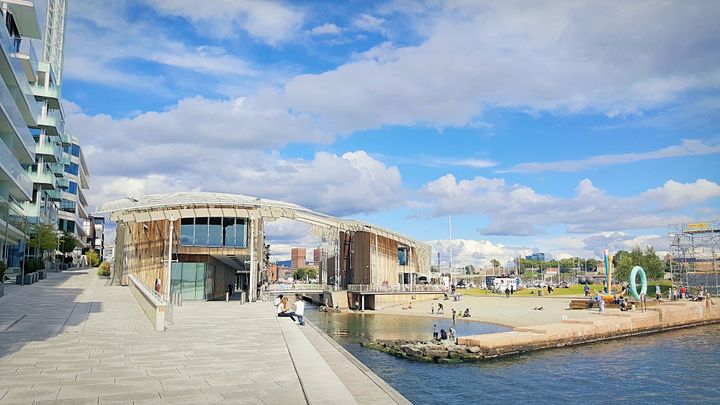
The Astrup Fearnley Museum of Modern Art and the Tjuvholmen City Beach.
aThe final stop on my itinerary was the Grand Hotel Oslo, arguably Oslo’s grandest and most well-known hotel, but, without question, the oldest luxury hotel in the city at more than 140 plus years old. That said, like at the Hotel Intercontinental’s Theatercaféen, all things old are new again at the Grand Hotel.
Having undergone a more than $250 million major renovation, the Grand Oslo continues to live up to its name and reputation as the foremost destination for Norway’s elite as well as guests ranging from world leaders and Nobel Peace Prize laureates to His Majesty King Harald V.

The Grand Hotel, Oslo.
Only stopping briefly to savor the sumptuousness of the marble sheathed lobby, I headed first to Eight, the Grand Hotel’s new rooftop bar. More eccentric and relaxed in design than the other boites in the hotel, Eight represents the best of the rooftop bar trend currently sweeping the globe. Signature cocktails from the bar’s mixologists are not only stellar but especially unique for blending flavors and ingredients unique to Norway. Add to that the impressive views of downtown, the Royal Palace and many of Oslo’s most famous landmarks and you have the recipe behing one of Oslos’s chicest watering holes.
Next it was off to a light dinner in the Othilia Lobby Bar at the Grand, which is, aside from Eight, another of the hotel’s most luxuriously relaxed spaces. What I particularly enjoyed about Othilia is that it is the sort of establishment that invites the feeling of a private club. Joined by a guest, I ordered a cocktail, a club sandwich, and a caesar salad while my friend ordered a burger and while we noshed and chatted well into evening, luxuriating in the comforts of the excellent service and the splendor of the grandiosely proportioned room. We also did a good bit of people watching which is precisely the sort of thing for which the expansive "see and be seen" room seemed meant.
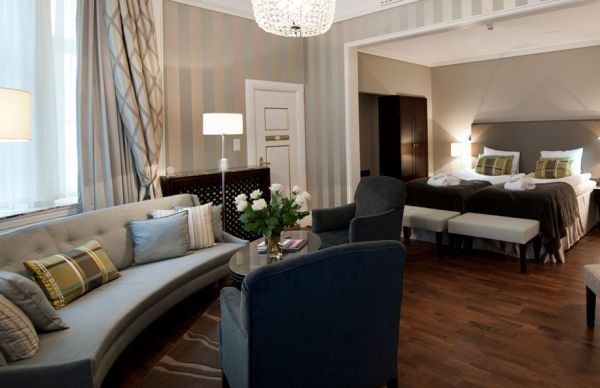
A Junior Suite at the Grand Hotel, Oslo.
It was both the perfect place and the perfect way to wind down my 48 hours in Oslo – right in the iconic hub of the city in one of its most iconic destinations.
Next stop Stockholm.
For more on my very royal tour, click here.
